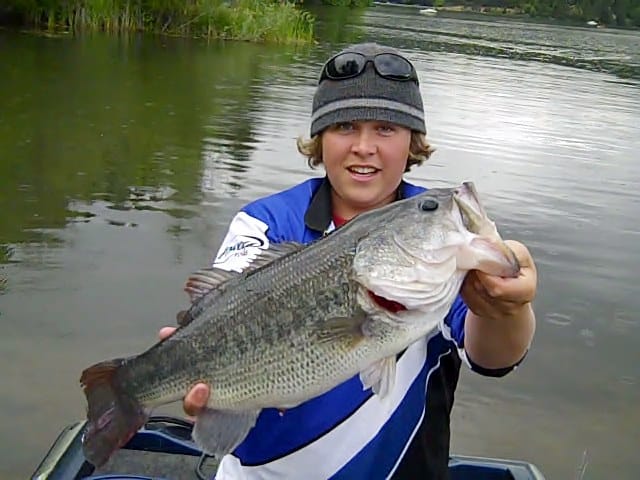Fishing for bass requires perseverance, dedication, and a bit of luck.
When you first begin fishing for black bass, including largemouth and smallmouth bass, you’ll find a natural progression to the sport. Most people don’t land a trophy on their first trip.
We will break down the best bass rods, lures, baits, plastics and techniques to help the beginning (as well as the intermediate) bass angler feel more comfortable on the water.
And you will begin to catch more bass. And likely bigger bass.
If you know where to go, how to present your bait, and what techniques to use, that is. When you start fishing for black bass, you can quickly find yourself overwhelmed with the terms, techniques, and tackle used.
We’ll try to simplify the process with this guide to the most important information.
Let’s start by looking into what a black bass is and why you want to catch one.
Types of Black Bass in America
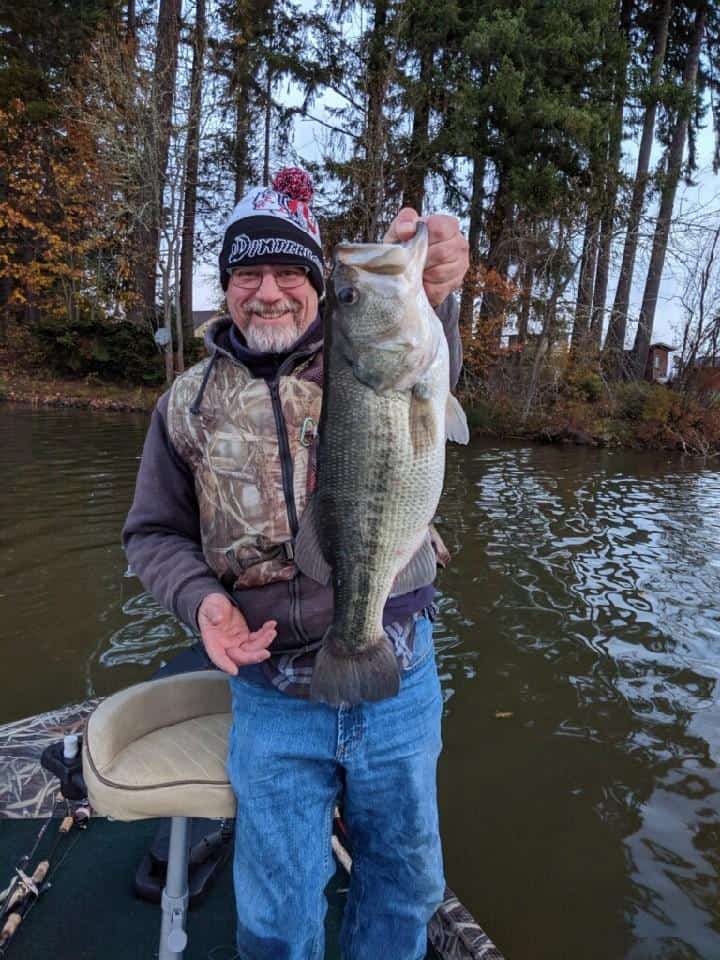
Freshwater bass are the most sought-after game fish in the country. They can be found in waters across the country and into Canada and Mexico.
Recently there was bass found in a lake in Alaska (though these were planted illegally and have a catch and kill order on them), and largemouth, smallmouth and sometimes other black bass are established sport fish in the other 49 states.
Black bass are freshwater fish with several variants. Each type will require a different approach, so being able to identify them will give you an advantage.
Largemouth Bass (largies) are prevalent in most states in the country and for many anglers are the prime target when bass fishing, thanks to their size and fight.
The largemouth’s upper jawline goes in past the eye, and the mouth is much bigger than on other bass. Largemouth bass also have a deep notch between their spiny dorsal fins.
Largemouths tend to flourish and grow biggest in warmer lakes and ponds, but they also can be found in waters that freeze over in the winter.
Largemouth bass find cover wherever it’s available. Between rocks, hiding in aquatic vegetation, around sunken trees, and any other cover that provides an excellent spot to ambush their prey will likely be holding fish.
Bass thrive in quiet, calm, warm water but are very adaptable to other conditions.
Smallmouth Bass (smallies) are also plentiful throughout the country and tend to live in clearer, cooler water than largies. Look for them in rocky cover and sandy bottoms when fishing lakes and reservoirs.
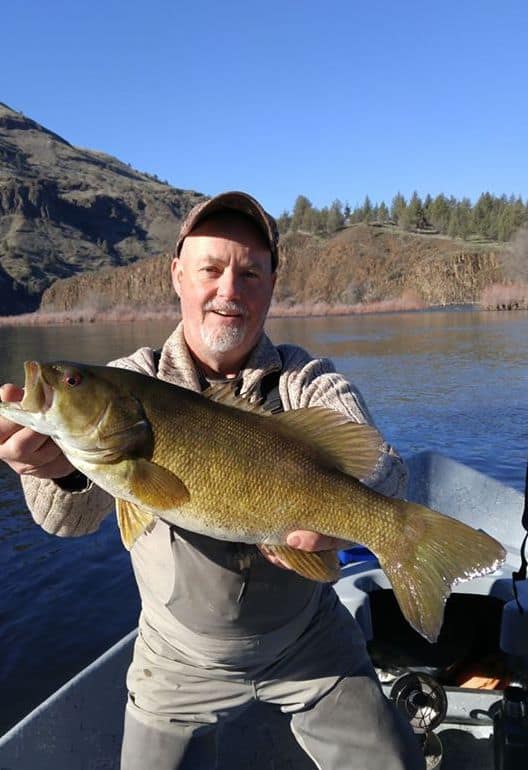
River fishing for smallmouths can be very productive.
Rivers and creeks can hold surprisingly big fish—target areas with cover that would allow them to stay reasonably hidden, such as behind boulders and ledges.
Smaller lures and soft plastics than you might use for largemouths tend to work well when targeting smallies.
The smallmouth’s jawline doesn’t extend past the eye, and they generally have three darker lines on their cheeks. The dorsal fin has nine to ten spines that can be quite sharp. Some smallmouths have bright red eyes that make them look mad.
Spotted bass are also referred to as Kentucky bass, Alabama bass, or spots.
They are a more aggressive ambush predator than their cousins and live in the same habitat as largemouth bass throughout the southeast. They also have been transplanted to other waters clear to the West Coast, though they aren’t as widespread as either largemouth or smallmouth bass.
When targeting spotted bass, use the same size lures and plastics as you would for largemouth bass.
Depending on the water and available forage, they can be anywhere from 11 to 25 inches. The upper jawline doesn’t pass the eye. These bass have lateral spots and soft dorsal fins with a shallow notch.
Florida bass, or Florida-strain bass, are technically a subspecies of largemouth bass. The upper jawline passes the eye, and the dorsal fin has nine spines.
These fish are found in Florida and elsewhere in the southeastern U.S., and they also have thrived and grown to massive sizes in other locations, particularly California.
Redeye bass have small dark spots under their lateral line and a second dorsal fin that looks red.
The upper jaw doesn’t extend past the eye, which is red. They are found in rivers and streams with gravel bottoms throughout North and South Carolina, Tennessee, Alabama and Georgia.
Red-eye bass are not typically found in lakes or reservoirs.
Other types of less-common black basses in the U.S. include the Guadalupe bass of Texas (the official state fish), the Cahaba bass of Alabama, and several basses native to the river systems of Florida and/or Georgia, including the shoal bass, Chattahoochee bass, Suwannee bass, Tallapoosa bass and warrior bass.
How to Catch Bass
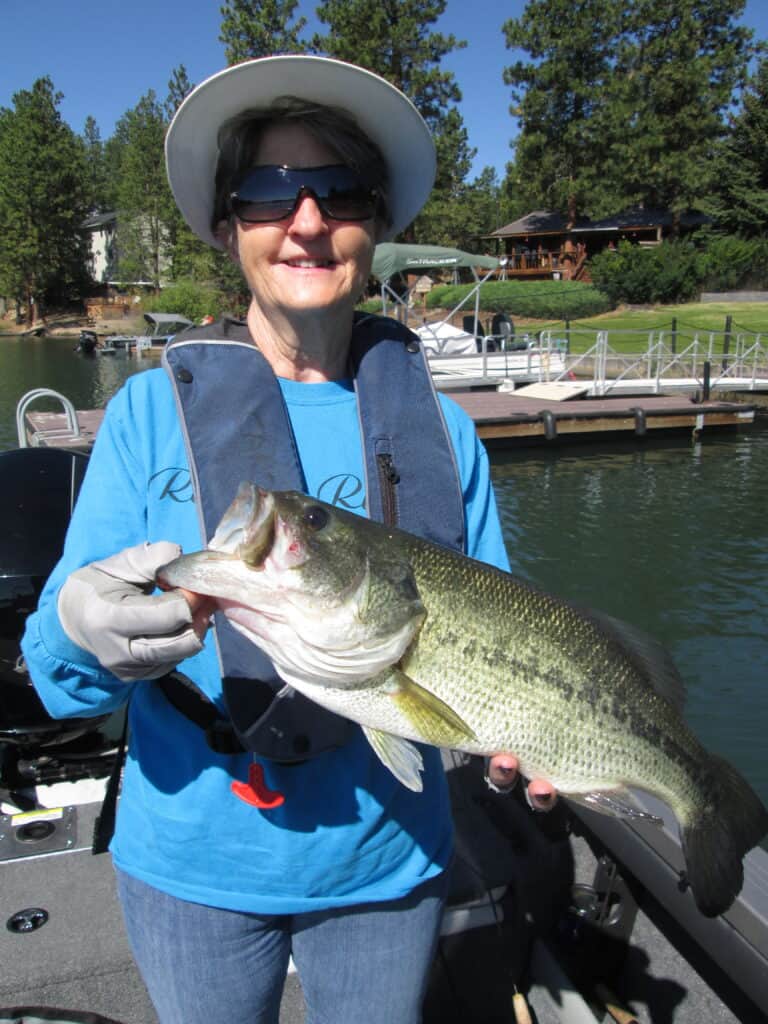
There are several ways to catch bass. Choosing the right approach for each water takes time, patience, and a basic understanding of how each bait type is fished.
One of the most fundamental things to know about bass fishing is bait color:
- Fish bright colors in muddy, silty, or dingy water.
- Bright colors will allow the bass to see the baits easier.
- Use light, subtle, natural colors in clear water.
- Chartreuse, bright yellow, orange, and red are great for silty, murky conditions.
- Use white, watermelon, green, pumpkin, browns, baitfish, and crawfish colors for clear water conditions.
Bass Fishing with Rubber Worms and Other Soft Plastic Lures
Soft plastics are very popular baits for bass.
They range in length from around 2 inches to well over 6 inches. Rigging a rubber worm is an easy way to start your bass fishing adventure.
There are multiple ways to rig soft plastics. Some attach to jigs as a trailer; others connect straight to the hook.
The most common riggings for rubber worms are the Texas rig, drop shot, and wacky rig. The Ned rig is gaining in popularity as well.
Here’s a look at several of those rubber worm bass fishing techniques:
Texas rig
The Texas rig is a great universal setup that works well in most situations while fishing with soft plastic baits. Let’s look at one way to set up the Texas rig.
You will need:
- Soft plastic bait
- Bullet-shaped sinker
- 3/0 or 4/0 hook
- Bobber stop or other pegging items.
Use a 3/0 straight or offset shank hook for most plastics up to six inches and a 4/0 for larger baits. Use a bullet weight that is the appropriate size for the depth and thickness of the cover.
Place the pegging item (such as a piece of rubber band) at the top of the weight to limit its movement. The weight helps slide through weeds and other cover without snagging up.
The Texas rig can be used in most situations. Cast out along the shoreline in the morning and evening, then use a slow to moderate retrieve. Cast out until you fish the entire weed bed or other cover.
Drop-shot rig
The drop-shot rig is excellent for finesse approaches. The weight is on the bottom with the bait floating 5-10 inches above. Every twitch you make with the rod moves the bait. This method works great for largemouth, smallmouth and spotted bass.
You will need:
- Size 1 or 2 drop shot hook
- Soft plastic
- Drop shot weight
Tie the hook to the mainline. The Palomar knot is ideal for this. Make sure the hook faces upward.
Leave a tag end on the knot about 18 inches in length. The tag line determines how high the bait will suspend above the bottom. Thread the tag back through the hook’s eye and tie the drop shot weight to the end.
Fish the drop shot by casting out from shore or dropping off the boat. Light taps up on the rod will keep the bait moving and draw in the bass.
Ned rig
The Ned rig has become a go-to for more serious bass anglers in recent years. If you find yourself in a situation where nothing seems to work, tie on a Ned rig. It is the perfect finesse bait.
You will need:
- Ned rig jig hook, 1/16 to 1/4 ounce or bigger
- Ned rig plastic baits. These are generally around 2 ½ to 3 ½ inches long
Attach the hook and then thread the bait on so it sits straight above the hook bend. Make sure the tail end can freely move.
Cast out and vary your retrieve. A slower retrieve seems to do the trick for me.
Bass Fishing with Crankbaits
Crankbaits can be one of the best lures for bass. Anglers can cover broad areas quickly using crankbaits. Crankbaits come in a wide range of sizes and colors, which often imitate the types of forage found in various waters, such as smaller fish and crayfish.
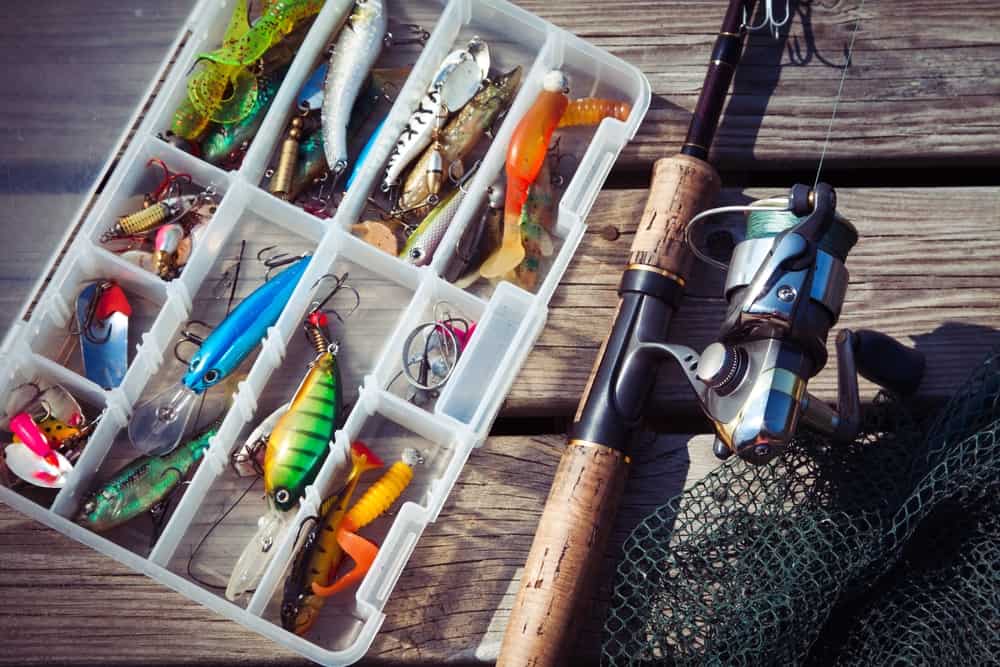
It is common to use crankbaits when exploring new waters to find the areas bass are stacking up in.
For starters, invest in a shallow diving crankbait and a deep diving one. Between the two, you will have enough variance of depth to cover the water column and discover where the bass are holding.
Choose more natural color patterns and choose the size based on the type of bass you are targeting. Use bigger lures for largemouth and spotted bass. Smaller lures are great for targeting smallies.
Determining the retrieval speed of crankbaits can take some practice. The typical crankbait will sink at a rate of 2-3 feet per second, so if you want to go deeper, keep that in mind.
Once it is down to the level you want, reel and lift the rod tip up. Stop reeling and lower the tip again, then repeat. Varying the speed mimics an injured minnow or baitfish.
Bass Fishing with Spinnerbaits
Spinnerbaits can be very productive when targeting all types of black bass. They do well in weeds and other vegetation due to their wire frame. With quite a bit of built-in action, spinnerbaits are pretty easy to use straight out of the package to catch bass.
Picking up a spinnerbait and getting on the water quickly makes them a great go-to for exploring new water. While you may be targeting bass, these baits will attract a wide range of freshwater gamefish.
The size and weight of the spinnerbait will determine the type of rod to use. If targeting smaller bass, use smaller spinnerbaits, and therefore spinning tackle will work. Heavier spinnerbaits are going to work better with a bait caster.
Cast the spinnerbait right into the cover being targeted. If possible, bounce it off a branch or top of a rock. The bass waiting for a meal will pounce as soon as the bait hits the water.
You want bass to strike quickly in a flash of aggression. A moderately quick retrieval will keep it under the water but still going fast enough to not allow the bass to get an exact look at it.
Bass Fishing with Jigs
The jig is useful for short casts to fish-holding cover and also works great for deeper water. Jigs are one of the more versatile bass lures around. Make sure you have a 3/8 ounce and a 1/2 ounce in your tackle box. These sizes work for almost every situation you’ll encounter.
Use a smaller size in shallower water or when you want the bait to fall through the water column slowly.
Heavier sizes will get the bait down in deep water quickly.
Jigs tend to imitate crawfish, making the choice of the trailing soft plastic color important. Make sure they match reasonably well. Watermelon, green pumpkin and other natural colors are all great options.
Use a black and blue jig and trailer when fishing murky, dirty or stained water.
Jigs can also imitate shad, bluegill and other sunfish if the colors match. Use white skirts and a white trailer for shad imitations and green pumpkin or a jig with blues for bluegill.
Topwater Bass Fishing
Most bass anglers agree that topwater fishing for bass is the most fun. Bass move lightning fast as sudden shadows darting out from cover to smash a topwater bait and are bound to get your heart pumping. Topwater baits come in several styles, from buzzbaits to frogs.
Use topwater lures early in the morning and in the evening. Overcast and cloudy weather can keep topwater baits productive all day.
Here are a few topwater lures that should be in every bass angler’s tackle box.
One of the best topwater lures there is the buzzbait. This lure is used to make noise on the surface while covering a wide area.
Find culverts, grass areas, docks or any other coverage in the water. Cast your buzzbait past the target area and bring it as close to the cover as possible. Then get ready for the fun.
The Whopper Plopper is another option for topwater. It has treble-hooks, so throwing it into thick cover won’t work, but over and around lighter coverage, this bait will bring them to the surface.
Poppers are perfect for after the spawn conditions. If nothing is producing a bite, try a popper.
A popper makes an incredible amount of commotion on the surface without having to move very far. It is liable to bring at least one fish to the net.
Bass Fishing with Bait
Bait fishing for bass can be a great time. Using minnows (where it’s legal) can result in larger, more aggressive fish.
Both small and largemouth bass are always looking for natural baits like the following:
- Minnows
- Worms
- Frogs
- Chubs
- Leeches
- And last but definitely not least, crayfish
If you reside in an area that allows the use of live bait, you’ll find out that bass will swallow the bait whole, hook and all. You need to pay extra close attention so you can set the hook at the first indication of a bite.
Swallowed hooks mean either more fish were taken or more line cut to release them. Some deep-hooked bass won’t survive.
Minnows are great bait and are available (where legal) in several varieties. Shiners, shad, chubs, red shiners and so many more are going to get you solid hookups, as long as you pay attention.
The very best live bait around is the crayfish (aka crawfish, crawdads, mudbugs, etc.). Bass will do just about anything to get ahold of a crayfish.
Fly Fishing for Bass
Fly fishing for bass is all about flash and noise. The flies used often are going to be pretty big, and the topwater retrieves are going to be as noisy as possible. Bass flies often resemble minnows, frogs or other common bass forage moving through the water.
Here is a breakdown of gear recommendations:
The fly rod needs to have enough power to handle a strong fish. A five or six weight 9-foot rod should be able to handle most situations very well. Using a weight-forward line will help get more distance casting the larger flies.
There are several options for leaders to choose from. Pick something with enough strength to handle the heavier flies and the cover you may be casting into.
You can buy tapered bass leaders, make your own knotted leader, or just tie on straight monofilament with leader. Make sure to use 10-15 pound test line.
A knotted leader is pretty simple to make. Use around 4 to 5 feet of 10- to 15-pound test mono, then tie 3 to 4 feet of 5- to 10-pound test. Bass don’t care about line knots as much as other species do.
The bass fly types you should have in your box are:
- Poppers in yellow, black, and green colors
- Frog imitations
- Oversized dry flies and stimulators
- Hopper and beetle imitations
And the casting presentations that work well are:
- Twitch, pause, twitch – cast to cover, let the fly sit for a few seconds, then twitch it a few inches, pause, and repeat.
- Fast retrieve – hit the target area, then strip line with irregular, fast motion.
- Strip, pause, strip – cast beyond the target area, let the line settle, then strip in 1-2 feet. Pause for 3-4 seconds and repeat. Vary the strip distance and speed each time to imitate a bait in trouble.
Here are some fly fishing tips for bass:
- When fishing poppers, let them sit until the water is calm again.
- Bass will often strike as soon as the fly hits the water. Be prepared by keeping slack out of the line.
- Set the hook with the line, not the rod. Bass mouths are touch, and fly rods are too flexible to get a rigid hook set.
- You can create weed guards for your flies if you keep getting snagged. Use some monofilament line to make the guard.
- Watch for sideways line movement. Sometimes bass will pick up the bait and carry it off without you realizing. Set the hook if you see this.
Where to Catch Bass
Bass are attracted to cover. Anything you see that provides cover and shade will be your best bet. Fish often will be in the shallows foraging early and late in the day, especially during warmer weather. They tend to move into deeper water during the heat of the day.
Bass are found throughout the country in rivers, lakes and reservoirs. They are opportunistic feeders that depend on shadows and cover to find prey.
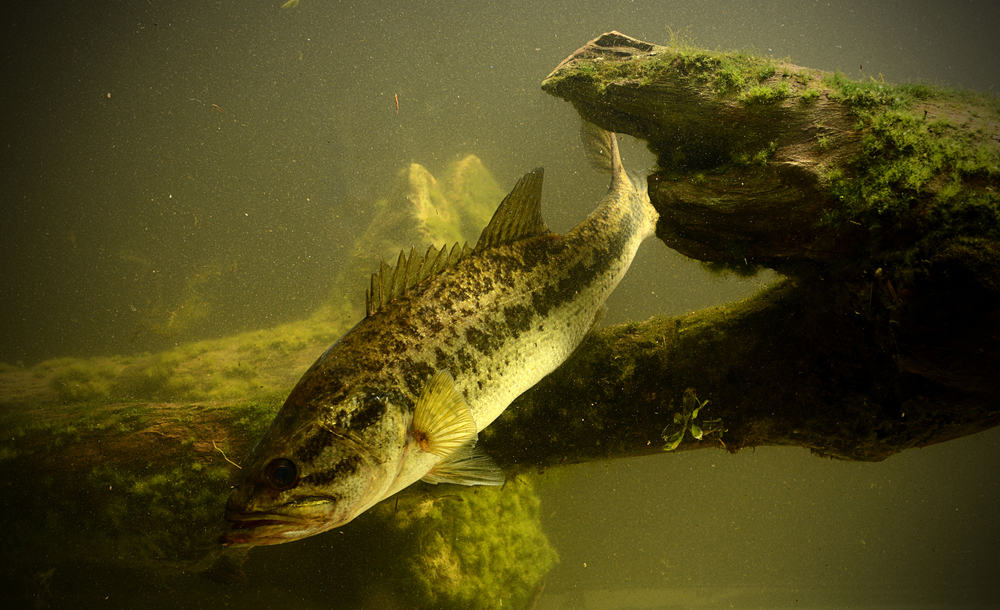
Lakes and Reservoirs
Take a quick scan of the water body to identify any apparent areas of coverage or structure. (Using Google Earth before getting out on the water can help you narrow down your prospects.)
If the shoreline has submerged trees and rocks, try casting along the cover’s edge, then retrieve. Your bait needs to imitate the natural forage in the area as closely as possible.
Rocky lakes and reservoirs with clear water will fish differently from shallower, murky lakes with lots of vegetation and downed trees.
Bass will find cover in rocks, but they tend to stay deeper with the clearer water, possibly even suspended instead of on the bottom.
Finding the bass in a rocky area can take more time. Studying the shoreline for outcroppings, points, ridges under the water, and any weeds or fallen tree cover is going to improve your chances significantly.
Many southern lakes and swampy and shallow lakes in other parts of the country as well, often provide plenty of vegetation, stumps, and fallen tree coverage.
These waters, especially in the South, are more likely to be murky and generally shallow. Hitting the bass-holding structures with crankbaits, spinnerbaits and soft plastics will generate results.
Rivers and Creeks
Targeting bass in rivers and creeks is a great way to spend a day outdoors. There are certain species, like the Redeye bass, that prefer rivers over lakes.
Smallmouth bass also very often inhabit moving streams, even rivers with fairly strong currents.
Bass in rivers and creeks often lurk in places where they can hide out of the stronger flows but dart out to snatch a passing minnow or other prey, such as behind boulders and ledges.
When to Catch Bass
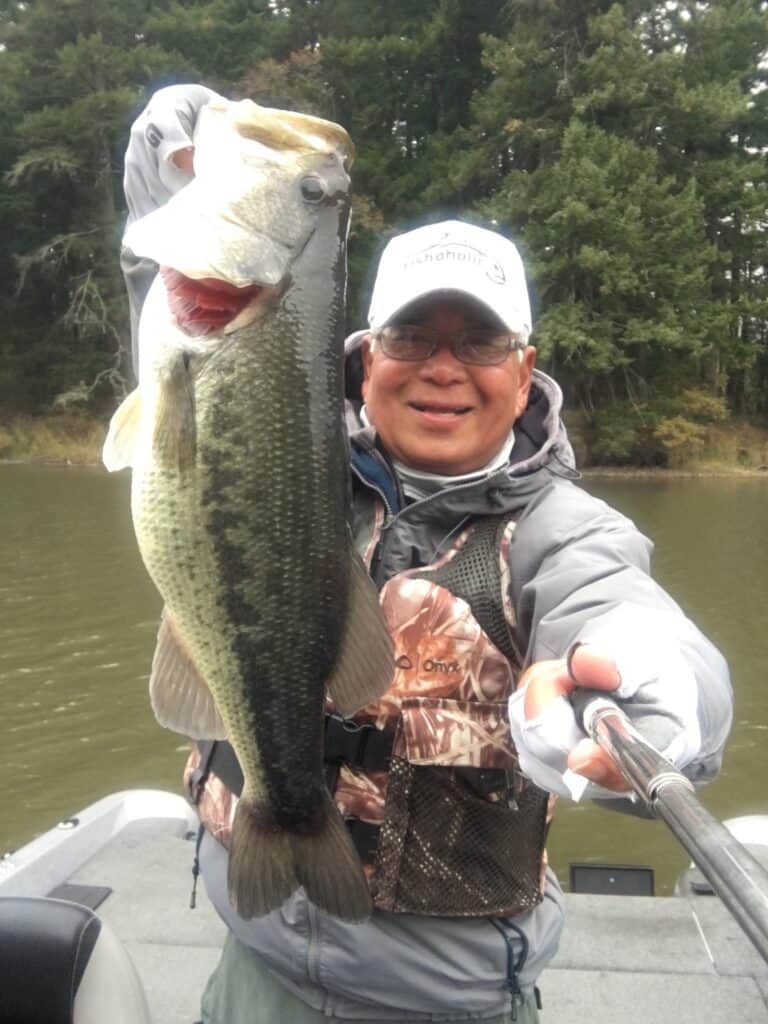
Bass fishing in Southern climates can often be a year-round possibility.
In the northern states, bass locations can become frozen over, making the fishing more difficult.
Ice fishing can be fun but is never guaranteed to be successful. When cold water hits, bass generally hang out near the bottom and can become reasonably lazy feeders compared to their warmer water gluttonous habits.
Here are some things to consider when fishing for bass in each season.
Spring
In the southern states, the bass bite starts picking up around the beginning of spring or even late winter.
Depending on water temperature, bass start to actively feed and guard territory in the shallows as they prepare for the spawn. You’ll find the bite to be very aggressive during this time as well.
The better bite often is a little later up north, where the water stays colder longer, although sometimes the largest bass are taken early in the season.
Fishing in the shallows will bring some of the best success of the year once bass move into spring mode.
Summer
Weather conditions and water temperature will dictate the location of bass in the summer.
Cooler temperatures will bring them to the shallows, where they can be targeted easily.
Bass may still feed in the shallows on hotter days because the baitfish will stay around that area, but these predators will probably hunt more active in the lower light of early mornings and evenings.
Topwater lures like poppers and frogs can work well around vegetation during the summer months. Bass tend to shelter in vegetation to stay out of the sun, so topwater lures will draw some pretty aggressive bites.
Fall
Bass are pretty active in the early to mid-fall months in many parts of the country as the fish fatten up for winter.
Fishing the shallows and any cover you’d target in the spring may bring you success, or be prepared to move just a little deeper to holding areas near good shallow habitat to find hungry bass ready to hunt.
Topwater lures like buzzbaits and poppers can still be very useful, as can crankbaits.
Winter
Winter isn’t the best time for bass fishing, as the bass are generally trying to conserve energy. They are typically going to be suspended in deeper water and will feed less because the cold water slows their metabolism down significantly.
It can be possible to catch bass in the winter. A slow and choppy retrieval may get the occasional bass to show interest and hit the bait.
Southern states may see bass moving into the shallows in winter if the temperature rises for a few days in a row.
Catch and Release
Just a word or two about this.
We often side with the many sporting bass anglers who release most bass we catch, and in particular the larger bass. (Technically, we actually practice catch & snap a photo for Facebook & release!)
Black bass take time to grow to trophy sizes. It’s those big ones that not only make the experience so addicting, they also are the major contributors of the next generation of bass.
While we do occasionally eat bass we catch, it’s typically the pan-sized fish up to about 12 inches, especially if there are lots in that age class. Those younger bass taste better and don’t put the same kind of dent in a fishery as taking large fish.
Also, frankly, we don’t find big bass to be as tasty as the smaller ones. Nor do we consider bass as good to eat as crappie, catfish, perch, walleye, and a myriad of other fish species available in many of the same waters as bass.
Lures that are moving tend to result in lip-hooked bass more often than natural baits such as minnows and nightcrawlers. Bass are quite likely to deeply swallow still- or slow-fished natural baits in particular, more often resulting in fatal injuries.
While you can cut the line close to the hook and sometimes save the fish, avoiding deep hook sets in the first place is the safer bet.
Conclusion
There you go: Take at least a handful of the above tips along and you now have no excuse to get out and catch some nice bass and have a blast doing it.
Best Black Bass Fishing
Click the following states to find the best bass fishing lakes and rivers in each location. These articles may include largemouth, smallmouth, spotted, and other types of black bass. We are currently in the process of adding more states.

